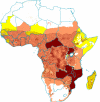The impact of HIV-1 on the malaria parasite biomass in adults in sub-Saharan Africa contributes to the emergence of antimalarial drug resistance
- PMID: 18647387
- PMCID: PMC2517597
- DOI: 10.1186/1475-2875-7-134
The impact of HIV-1 on the malaria parasite biomass in adults in sub-Saharan Africa contributes to the emergence of antimalarial drug resistance
Abstract
Background: HIV-related immune-suppression increases the risk of malaria (infection, disease and treatment failure) and probably the circulating parasite biomass, favoring the emergence of drug resistance parasites.
Methods: The additional malaria parasite biomass related to HIV-1 co-infection in sub-Saharan Africa was estimated by a mathematical model. Parasite biomass was computed as the incidence rate of clinical malaria episodes multiplied by the number of parasites circulating in the peripheral blood of patients at the time symptoms appear. A mathematical model estimated the influence of HIV-1 infection on parasite density in clinical malaria by country and by age group, malaria transmission intensity and urban/rural area. In a multivariate sensitivity analysis, 95% confidence intervals (CIs) were calculated using the Monte Carlo simulation.
Results: The model shows that in 2005 HIV-1 increased the overall malaria parasite biomass by 18.0% (95%CI: 11.6-26.9). The largest relative increase (134.9-243.9%) was found in southern Africa where HIV-1 prevalence is the highest and malaria transmission unstable. The largest absolute increase was found in Zambia, Malawi, the Central African Republic and Mozambique, where both malaria and HIV are highly endemic. A univariate sensitivity analysis shows that estimates are sensitive to the magnitude of the impact of HIV-1 infection on the malaria incidence rates and associated parasite densities.
Conclusion: The HIV-1 epidemic by increasing the malaria parasite biomass in sub-Saharan Africa may also increase the emergence of antimalarial drug resistance, potentially affecting the health of the whole population in countries endemic for both HIV-1 and malaria.
Figures

 . < 10% Parasite Biomass increase*
. < 10% Parasite Biomass increase*  . 10–99% Parasite Biomass increase*
. 10–99% Parasite Biomass increase*  . ≥ 100% Parasite Biomass increase*
. ≥ 100% Parasite Biomass increase*  . *High Malaria Transmission areas shaded.
. *High Malaria Transmission areas shaded.
 . < 3 *109 parasites/individual at risk increase*
. < 3 *109 parasites/individual at risk increase*  . 3–20*109 parasites/individual at risk increase*
. 3–20*109 parasites/individual at risk increase*  . ≥ 20 *109 parasites/individual at risk increase*
. ≥ 20 *109 parasites/individual at risk increase*  . *High Malaria Transmission areas shaded.
. *High Malaria Transmission areas shaded.
References
-
- Whitworth J, Morgan D, Quigley M, Smith A, Mayanja B, Eotu H, Omoding N, Okongo M, Malamba S, Ojwiya A. Effect of HIV-1 and increasing immunosuppression on malaria parasitaemia and clinical episodes in adults in rural Uganda: a cohort study. Lancet. 2000;356:1051–1056. doi: 10.1016/S0140-6736(00)02727-6. - DOI - PubMed
-
- Atzori C, Bruno A, Chichino G, Cevini C, Bernuzzi AM, Gatti S, Comolli G, Scaglia M. HIV-1 and parasitic infections in rural Tanzania. Ann Trop Med Parasitol. 1993;87:585–593. - PubMed
-
- Steketee RW, Wirima JJ, Bloland PB, Chilima B, Mermin JH, Chitsulo L, Breman JG. Impairment of a pregnant woman's acquired ability to limit Plasmodium falciparum by infection with human immunodeficiency virus type-1. Am J Trop Med Hyg. 1996;55:42–49. - PubMed
MeSH terms
Substances
LinkOut - more resources
Full Text Sources
Medical

